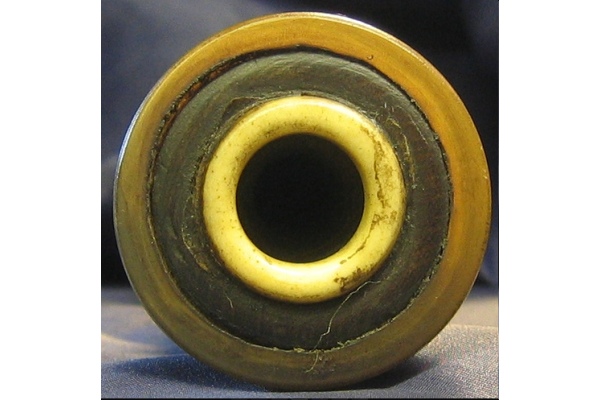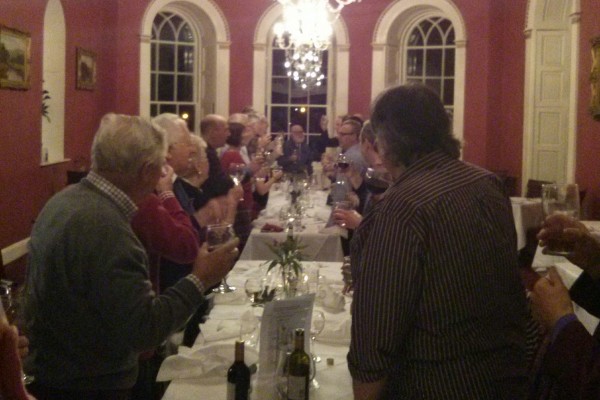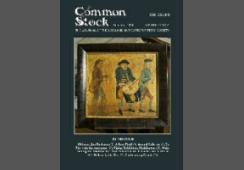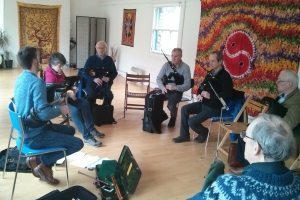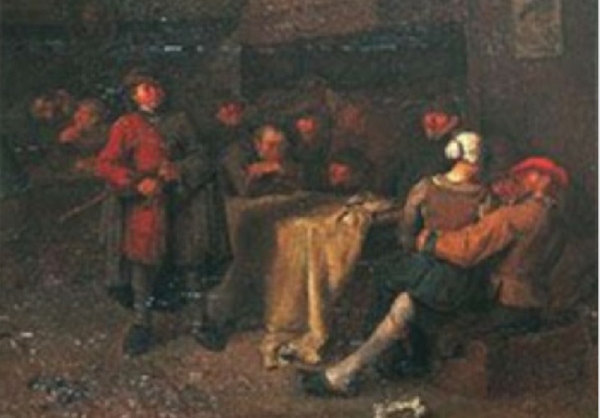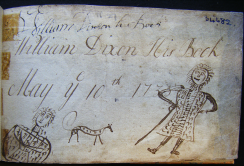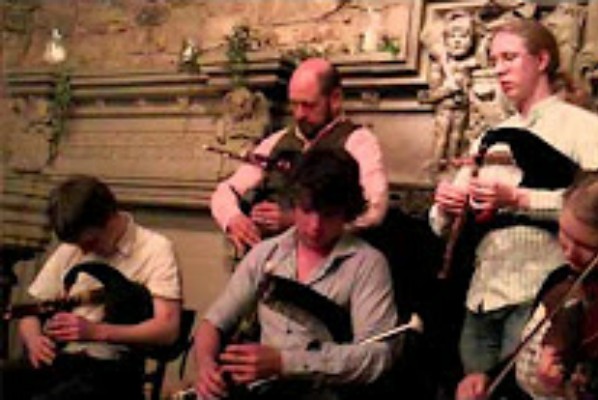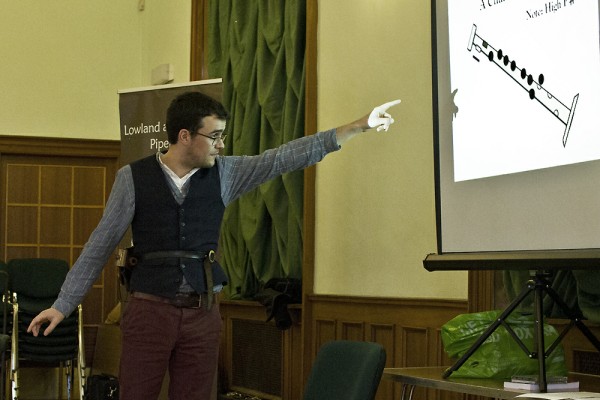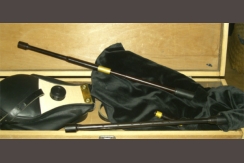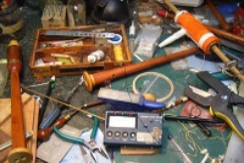Hugh Cheape sent us this review of a review of his book Bagpipes, first published in 2008.
The publication of the National Museums Scotland’s Bagpipes in 2008 attracted a review published in the journal of Na Píobairí Uilleann. The review was very fair and made points about the inadequate-to-poor coverage of Ireland’s piping culture. This called for a gentle response and for a reassertion of the counter emphasis in the book on a wider ‘Union Pipe’ tradition. These were Na Píobairí Eile – ‘the other pipers’ – of my title here. Though more than seven years have passed since the review and response, the salient points, I believe, are still useful for current research. They may be relevant for any enterprise that takes forward the musicology of bagpipes, in the context, for example, of the Edinburgh University Collection of Historic Musical Instruments’ ‘Collecting Cultures Project’ of 2008-2013 which has laid up a wealth of fresh evidence for piping ‘organology’.]
The extended review in An Píobaire Vol. 4 No. 47 of the recently-published Bagpipes. A National Collection of a National Instrument, was generous and scholarly. The commentary and attention to detail call for a reply, in the interests of mutual understanding and of cordial and fraternal relations.
The initial response to the book when published, as your reviewer has described, was disappointing in light of its serious intent and, on a personal level, of the amount of thought and effort that it had absorbed. There was indeed a number of rather banal newspaper articles which narrowed the focus of a relatively wide-ranging work to the single nuanced conclusion about how the Great Highland Bagpipe might have evolved around about 1800. There were also four or five radio interviews and a television interview for the BBC Gaelic Service. The worst radio interview was with ‘Radio 5 Live’, involving a barrage of silly questions tending to ridicule Scotland’s love-affair with piping and the wretched interviewee being cut off when his 15 seconds time-slot was spent. The best interviews were with Belfast and Derry, outstanding for their courteous and intelligent questioning and the time made for comment and discussion. There was a more recent interview with ABC in Australia, similarly marked for its intelligence and courtesy.
Your reviewer’s health-warning on the book’s effect on Irish blood-pressure concerns me as author in that I wish ill of no man, but believe at the same time that Irish constitutions are too powerful to be hurt by any possible slight. For all the book’s faults in its treatment of Irish culture (as generally perceived), I would stand by a brief summary (page 105) and the integrity of material evidence:Modern perception of the Union Pipe has defined and described it in terms of Ireland’s culture and the Uilleann bagpipe of today. By contrast the instrument’s surviving ‘material culture’ suggests that the Union Pipe has been a shared and Neo-Baroque tradition and that an integrity has been ignored or laid aside in sustaining modern perceptions. The mindset of today may still regard the North Channel as an edge or a boundary, rather than a ‘highway’ with the same community living on both sides of it, and such a view makes the recognition of shared cultural traits more difficult. The Union Pipe has crossed and re-crossed the Sea of Moyle - Sruth na Maoile - and its points of departure and coming to land are still difficult to define with certainty.
Bagpipes has been published by the National Museums Scotland, and I am most grateful to your reviewer for his comments on its quality. A work of this length and complexity requires compression to bring it within the reach of pipers and the public. This work compares significantly with the notoriously high price of recent bagpipe books of major importance which are far out of monetary reach of the player community and, in my experience, are lost to sight - even their titles being unknown to folk who take an interest in our musical culture. In order therefore to keep the book reasonably priced and also maintain quality and a quota of illustrations, it has been packaged within the compass of just over 150 pages. Together with a CD of pictures, sound files and around 150,000 words (forby the word-count of the book itself), it comes in at the extraordinarily modest price of £15.99 - or about €20. I would like to think that I am master of my facts but I am not a master of my marketing and, for this and much more (like patience and encouragement), I am deeply grateful to my publisher Lesley Taylor and her team in NMS. To bring this book to all communities, much has to be sacrificed in order to sustain and address adequately the theme of the work. Inevitably perhaps mistakes creep in (for which I am responsible), but also expectations may be frustrated. Perhaps the most important statement of the book is the qualifying comment in the opening page of ‘Acknowledgements’ (page iv) that: ‘This work makes no claim to be a definitive history of the bagpipe in Scotland; its aim is different. In offering some account and analysis of the musicology of the bagpipe in its European context, its aim principally is to ask questions posed by the surviving material culture of the instrument.’ This amounts to a report on the ‘organology’ of the bagpipe in Scotland, on what is available in museums for public and hopefully free scrutiny. This has never been done in Scotland before; the primary evidence assembled, the well-thumbed secondary literature laid aside - what I have dared to dub the ‘grand narrative’ of Scotland’s past - and the investigator turning to first principles.
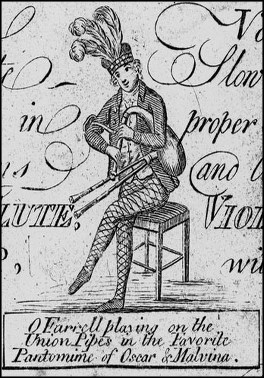
Patrick O’ Farrell, as depicted on the title-page of his Collection of National Music for the Union Pipes, printed and published in London in about 1804. Dressed as a ‘stage Highlander’
At the beginning and end of the book, a wry look is taken at Scotland’s love-affair with the bagpipe. If we valued it highly, we have been remarkably careless about its history. My contention is that the documentation of old instruments was poor to non-existent, betraying the same age-old condescending attitude and thin commentary, with the casual and humiliating exclusion of the bagpipe from the scholarly arena of musicology. A simple but too-typical example of my complaint was the musette belonging to Bonnie Prince Charlie described as ‘old Irish bagpipe’ (pages 10-11), a label curiously and often applied without further investigation to any bellows bagpipe. Of course this may also be a pale reflection of an eighteenth-century usage. There has been no ‘national collection of the national instrument’, but a collection has now been amassed within the public domain and critical comment offered on it. This is, within these constraints, the comparatively narrow focus of the work. It should at least offer precepts, guidance and prompts for further work, based on the 2,100 records now available.
Chapters 2 and 3 evolved as tentative (but not dogmatic) answers to the generally elementary questions about bagpipe origins sent to the National Museum and agonised over by me for almost 30 years. In suggesting that the bagpipe becomes established in the sixteenth and early seventeenth century Highlands, I do not believe that the bagpipe was unknown before then, only that this was the era when its status expanded and grew. But by contrast then with Ireland, there does not seem to be such early linguistic evidence for the instrument in Scotland. I am not sure that I repeat the equation of the name MacCrimmon with ‘MacCriomhthain’ (page 68?). I have addressed this topic in more detail in the Transactions of the Gaelic Society of Inverness (volume 62) and still believe that the name ‘belongs’ to Ireland, a point contributing to the thesis of Chapter 4, ‘Traditional Origins of the Piper Dynasties’. The reviewer must be correct in suggesting that the members of the professional piping dynasties were aligning themselves with the high status learned orders, bringing us back of course to the cultural well-spring of Ireland. In the same context, it is the ‘differences’ between Ireland and Scotland, and their Gaeltachts, as teased out by Kenneth Nicholls and Wilson McLeod, that could help to explain phenomena such as the classic form of Ceòl Mòr. The issue of ‘Irish piobaireachd’ was addressed in some detail in my thesis, looking for instance at pieces such as ‘MacNeil is lord here’, but had to be left out of a book on the material culture and national collection. There is, I hope, sufficient in the book to alert folk to the topic, (for example pages 47, 60 and 86) using among others the researches of Breandan Breathnach and drawing them firmly to the attention of Scots. The work of Allan MacDonald is of course implicit. And I feel like the old seanchaidh who at this point would say: ‘See, if Ailean was here, he wid tell ye!’ I had hoped too that I offered a stern enough precept (page 61): ‘Nevertheless, for the understanding of Highland piping, its historical context, as well as broader issues of cultural roots and mores, we ignore Ireland at our peril.’ This, dear readers, was my own health-warning to the good folk of Scotland after following your reviewer’s published researches through the years.
Chapters 5 and 6 ‘are of particular interest ... to Irish readers’, as your reviewer avers. They are however aimed principally at Scottish readers who have never been given much account of their ‘Irish pipe’ tradition, indeed have been starved of every detail. I, who had taken an interest in Scotland’s Irish pipe tradition, could not have reasonably waited for Ireland to supply chapter and verse. After all, the evidence resided in Scotland itself. Bagpipes, and the thesis on which it is based, gives considerable space to this cultural, political and historiographical myopia. I would beg Irish readers to learn from this blight in the interests of mutual understanding. Many other details concerning Ireland are of course inadequately covered in the book and your reviewer may fairly take the author to task. He has tried to strike a balance, and the balance involves admitting Scotland to any Union Pipe debate in the first place. This is the question posed by the mass of material, especially if it bears Edinburgh, Glasgow, Aberdeen, Newcastle and London marks. Somebody must try to give an account of it and to offer a fresh look. In weighing up the evidence, I am not sure if I am convinced in every case of what instrument an ‘Irish piper’ was playing; for example, an early court case in an action for damages in Stirling involved the prosecution of a Highland piper callit Broun. His dog had savaged one of the lieges. Personally I would not feel able to describe his instrument with confidence. I would not like to think that I had denied Geoghegan a proper pedigree; if so, mea culpa. His ‘Tutor’ now has a surer publication date which is highly intelligible given the troubles of the times (see Seán Donnelly’s essay in An Píobaire Vol. 4 No. 47, pages 26-27). I have connected John Geoghegan speculatively with Ulster or Leinster but placed him also in the context of a contemporary Irish migration to London. This was as important for Scotland but scarcely admitted in any cultural or musicological account of the eighteenth century. I was also suggesting that Geoghegan may have ‘imitated’ the style of Hotteterre’s 1738 treatise on the musette (page 81). I have treated Geoghegan’s work at some length (pages 83-87) and tried to do so without any preconceptions and with the excitement of discovery of a mint copy (with unique manuscript additions) in the National Museums Scotland. I have commented that it drew on Playford’s and Oswald’s publications (page 86).
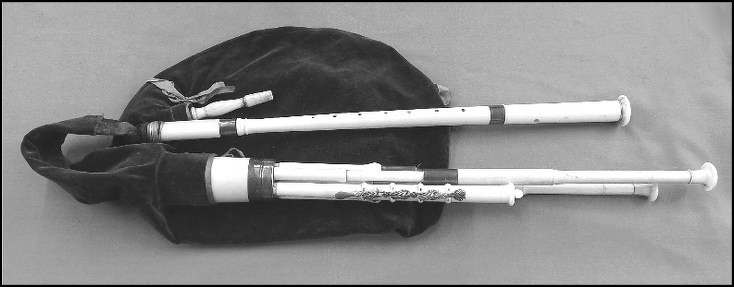
The magnificent set of ivory pastoral pipes now in the Edinburgh University Collection of Historic Musical Instruments
(image courtesy of Gardiner-Houlgate Auction Rooms)
I still believe that we should be curious about the so-called ‘Pastoral Pipe’ (and I use the label with care, see page 84). I would claim from the surviving material that Scotland played a notable part in this tradition. The book gives plenty space (pages 94-101) to the survival of the tradition in the North-East of Scotland. No one could expect others to write up this phenomenon. This is a special enclave of the history of the Union Pipe which should be of interest to Ireland, with a complex background which must be treated sensitively, with its ‘... distinctive blend of humanism, a conservative background of Episcopacy, the two music schools of St Nicholas’ and St Machar’s, an inheritance of a big house ‘court culture’, and a rural hinterland which has boasted the richest ballad tradition in Scotland and beyond’ (page 95). Aberdeen was the source of the first published secular music in Scotland with the Forbes Cantus of 1662, whose Preface claimed the city as ‘the Sanctuary of the Sciences, the Manse of the Muses, and the Nursery of all the Arts’. Tendentious perhaps, and we all have our conceits, but they were talking about contemporary Europe. And this was the background of makers such as Naughtan, Sharp, Davidson, Massie and others, who enjoyed continuous patronage, and Pastoral and Union Pipe players of distinction such as Robert Millar (pages 121-122).
Your reviewer very rightly asks that a balance should be struck, but the ‘balance’ may well be differently perceived or defined at different times and in different places. This we should be aware of. I hope that I have given the overall impression that Ireland’s links with the Union Pipe are of course the strongest, although we should continue to be curious in Scotland that there are so many Scottish (and English) made instruments and that Messrs Robertson, MacDonald, MacGregor and others made their early reputations on Union Pipes. Scotland then had its share of makers and, curiously, that distinctive caste of the ‘gentleman-piper’ (pages 109-110), all largely written out of the history of piping. Until recent articles in the Seán Reid Society and other journals, I had seen very little mention of Scotland’s share in the Union Pipe tradition. Coming to these matters therefore with as little preconception as possible, I wanted to provide some description of the wealth of material in the National Museums Scotland and other museum collections (and we passionately hope in Ulan Bator), and explain why it is there and the cultural world from which it came.
My guilt or my fault, which I freely admit, is that I have written a book for Scotland and for the piping community of Scotland. I hope too that I might have launched a ferry boat on Sruth na Maoile which can take a two-way traffic. In all modesty or humility, I could not have expected to have built a bridge.
Hugh Cheaps
Sabhal Mòr Ostaig
Colaiste Ghàidhlig na h-Alba
